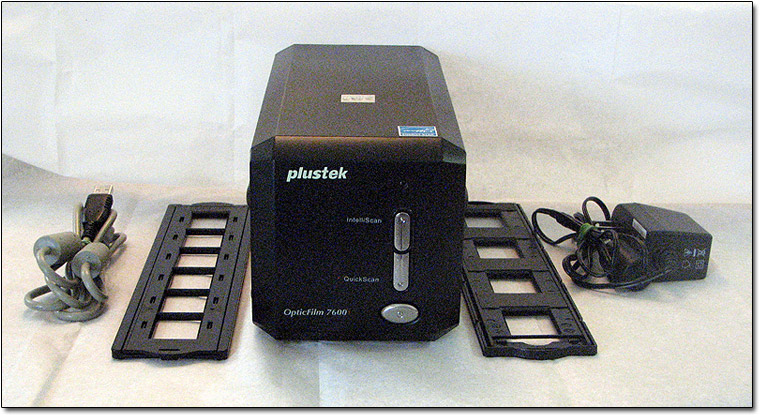Let me say up front that Iím not a professional writer, photographer, or equipment reviewer. Iím therefore qualified to do all three.
Why a film scanner you may ask? The majority of cameras used these days seem to be digital. Sure thereíre a few holdouts still using film, and others who do both, but the vast majority of photographic images being captured today are being captured digitally.
What about all those closets, storage bins, and shoeboxes, filled with negatives and slides?
Sure! You can take them to the local Target, Walmart, Costco, Processing Lab, etc. and have them do the digitizing for you. If thereíre only a few images involved, it makes perfect sense. If however thereíre hundreds, or perhaps even thousands, that method can get pretty expensive.
Thatís when having your own scanner comes in handy.

The Plustek 7600i Ai, is by no means cheap. Not quite $500.00 in B&Hís, summer 2012 catalog. Two other scanners in the Plustek OpticFilm series, the 7400, and 7600i Se, $279.99 and $352.95 respectively are also listed. The difference in pricing has more to do with the bundled software than the cost of the scanners themselves. This review however is about the scanner (7600i Ai) and its own, Plustek software (version 3.60.0.12) rather than the bundled Silverfast software it comes with, and thatís what Iíll try to stick to.
The scanner itself measures 10.5 inches deep x 4.5 inches high x 4.5 inches wide. Interface with the computer is USB2, and the scanner seems to be well constructed. The same canít be said of the film and slide trays, one each of which comes with the scanner. Additional trays are available from Plustek www.plustek.com and I do recommend getting them. Flimsy construction aside, with proper care, the trays should last a good while.
Scanning is accomplished in one of two ways. Intelliscan uses the bundled Silverfast software with all its bells and whistles. Quickscan uses the Plustek software. Simple, user friendly, far fewer bells and whistles (none to speak of actually), but perfectly acceptable (at least for non-professional use). The images included with this review (except for those of the scanner and its equipment) were all done using the quickscan method, with no post-scan editing accept for resizing and flipping to vertical where necessary. Yes, flipping to vertical. Version 3.60.0.12 of the Plustek software, does all its prescanning, and scanning on the horizontal. If the image was captured vertically and you want to flip it to that orientation, you do it in a post-scan editing or sort phase. I should also mention here that feeding of the film or slide trays, is a manual operation. Push them through from the right. Pull them out from the left.
Pre-session adjustments cover source (negative or positive), format (jpg, tif, pcx, bmp), and thereíre no adjustments for quality or compression level. Mode (8 bit grayscale, 16 bit grayscale, 24 bit color, 48 bit color). Resolution (up to 7200dpi). For my purposes I donít go above 1800. An 1800dpi scan in jpg format, gives me on average, an approximately 4 megapixel image, occupying somewhere between 1 and 1.5 megabytes of storage (perfectly adequate for an 8x10 to hang on a wall). Filter (none, average, blur, sharpen, etc). Units (mm, cm, inch). Brightness, contrast, gamma (donít know what gamma is, but itís there), preview, auto process, etc. You can also designate a special folder to save the scanned image too, as well as a base, filename (N066A95x for example). The program tacks on a generic (0000, 0001, 0002, etc), which like the orientation, can be changed to something more meaningful later. The bundled Silverfast software, gives you many more options, but as I said earlier, thatís not what this review is about. I should also add here that although the options are selected prior to the start of the scanning session, some of them (brightness, contrast, resolution, etc) can be changed in the pre-scan (yes there is a pre-scan), and the pre-scan frames borders can be changed by dragging. Scanner noise is minimal, and despite the manual feed, I can go through a set of 36 frames (negatives) in less than half the time it takes me to go through that same set with my other scanner (an auto-feed, Minolta Dimage Scan Dual IV).
One other point Iíd like to make here, and I rarely see this mentioned in equipment or any product reviews for that matter. How a company handles customer service and technical issues relating to its products, says quite a bit about what that companyís like, and how it operates with respect to its customers. On that score (as far as Iím concerned), Plustek gets high marks. I think the longest time Iíve spent on hold with them is probably less than 5 minutes. If they canít work with you right then, they ask you to leave a message so they can get back to you, and thatís exactly what they do. I get the distinct impression that theyíre in it for the long haul. Coupled with a good product, and good service, thatís a winning combination.
Ezra Schultz - NPN 5069
|
 Brooklyn based Ezra (Izzy) and Carolyn Schultz (thatís not her in the picture) took early retirement to pursue their passion for travel and photography. Most of what they do now is digital, but they havenít quite given up their film cameras. Their primary focus is the natural world, but they donít restrict themselves to that genre. Publishing credits include The Encounter NPN December 2010, Eden Below The Equator NPN February 2010, and Photo Tips DIY Camera Poncho NPN June 2001. They maintain a website at www.naturalworldandfarawayplaces.com
Brooklyn based Ezra (Izzy) and Carolyn Schultz (thatís not her in the picture) took early retirement to pursue their passion for travel and photography. Most of what they do now is digital, but they havenít quite given up their film cameras. Their primary focus is the natural world, but they donít restrict themselves to that genre. Publishing credits include The Encounter NPN December 2010, Eden Below The Equator NPN February 2010, and Photo Tips DIY Camera Poncho NPN June 2001. They maintain a website at www.naturalworldandfarawayplaces.com